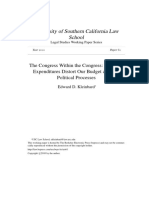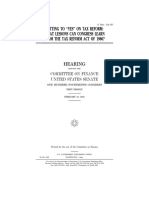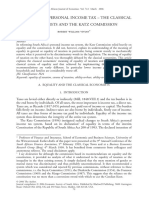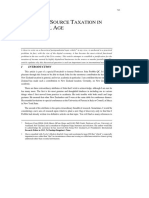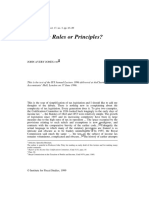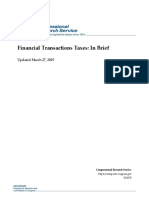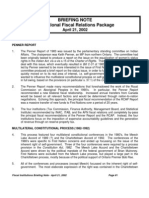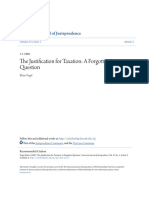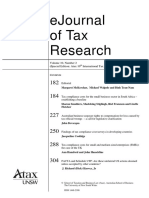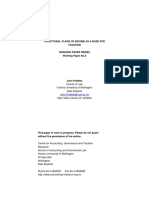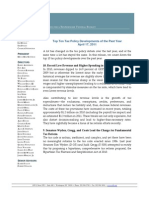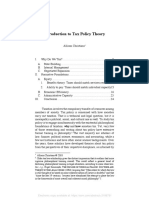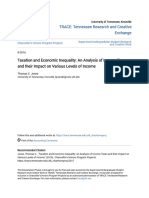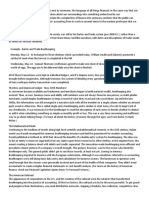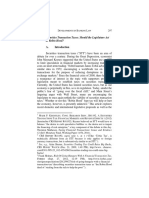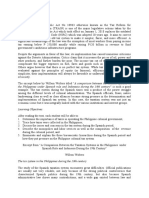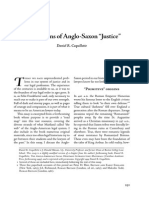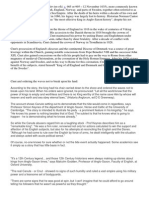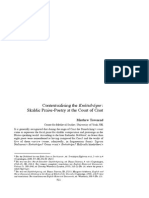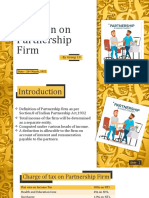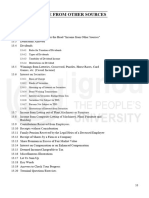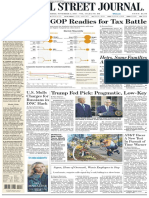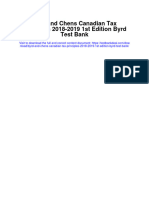0 ratings0% found this document useful (0 votes)
74 viewsOhio Northern University Law Review Woodworth Memorial Lecture
Ohio Northern University Law Review Woodworth Memorial Lecture
Uploaded by
oierulThis document summarizes a lecture about lessons that can be learned from the Tax Reform Act of 1986. It discusses how President Reagan understood that politicians cannot control certain fundamental economic laws and forces, like the tides. It describes how the Treasury Department's 1984 analysis identified tax distortions and recommended reforms to level the playing field. While the 1986 Tax Reform Act differed from the original analysis, it made progress in reducing distortions. However, the Act also had flaws, such as perfecting the double taxation of corporate income without preventing ways to avoid it through pass-through entities.
Copyright:
© All Rights Reserved
Available Formats
Download as PDF, TXT or read online from Scribd
Ohio Northern University Law Review Woodworth Memorial Lecture
Ohio Northern University Law Review Woodworth Memorial Lecture
Uploaded by
oierul0 ratings0% found this document useful (0 votes)
74 views18 pagesThis document summarizes a lecture about lessons that can be learned from the Tax Reform Act of 1986. It discusses how President Reagan understood that politicians cannot control certain fundamental economic laws and forces, like the tides. It describes how the Treasury Department's 1984 analysis identified tax distortions and recommended reforms to level the playing field. While the 1986 Tax Reform Act differed from the original analysis, it made progress in reducing distortions. However, the Act also had flaws, such as perfecting the double taxation of corporate income without preventing ways to avoid it through pass-through entities.
Original Description:
olson
Original Title
Olson
Copyright
© © All Rights Reserved
Available Formats
PDF, TXT or read online from Scribd
Share this document
Did you find this document useful?
Is this content inappropriate?
This document summarizes a lecture about lessons that can be learned from the Tax Reform Act of 1986. It discusses how President Reagan understood that politicians cannot control certain fundamental economic laws and forces, like the tides. It describes how the Treasury Department's 1984 analysis identified tax distortions and recommended reforms to level the playing field. While the 1986 Tax Reform Act differed from the original analysis, it made progress in reducing distortions. However, the Act also had flaws, such as perfecting the double taxation of corporate income without preventing ways to avoid it through pass-through entities.
Copyright:
© All Rights Reserved
Available Formats
Download as PDF, TXT or read online from Scribd
Download as pdf or txt
0 ratings0% found this document useful (0 votes)
74 views18 pagesOhio Northern University Law Review Woodworth Memorial Lecture
Ohio Northern University Law Review Woodworth Memorial Lecture
Uploaded by
oierulThis document summarizes a lecture about lessons that can be learned from the Tax Reform Act of 1986. It discusses how President Reagan understood that politicians cannot control certain fundamental economic laws and forces, like the tides. It describes how the Treasury Department's 1984 analysis identified tax distortions and recommended reforms to level the playing field. While the 1986 Tax Reform Act differed from the original analysis, it made progress in reducing distortions. However, the Act also had flaws, such as perfecting the double taxation of corporate income without preventing ways to avoid it through pass-through entities.
Copyright:
© All Rights Reserved
Available Formats
Download as PDF, TXT or read online from Scribd
Download as pdf or txt
You are on page 1of 18
1
Ohio Northern University
Law Review
Woodworth Memorial Lecture
And Then Cnut Told Reagan . . .
Lessons from the Tax Reform Act of 1986
*
PAMELA F. OLSON
Let me begin by saying what an honor it is to deliver a lecture named
for Dr. Laurence Woodworth. I never had the opportunity to work with Dr.
Woodworth, but I understand the admiration and respect his colleagues had
for him from the reverential tone in their voices when they wonder, more
than thirty years after his passing, what Larry would do about a thorny tax
issue. Given the sway he reportedly held with senators and congressmen in
advising them on policy, we could certainly use his talent now.
In the first part of the 11th century, Cnut the Great, the second son of a
Danish king, led the conquest of England, his native Denmark, Norway, and
finally parts of Sweden. Like all Scandinavians, Cnut was a practical man.
He modestly described himself as king of all England and Denmark and
the Norwegians and of some of the Swedes . . . .
1
Reports suggest that he
came to the control of this broad territory in like manner to his Viking
forebears, which is to say, violently, but that once in power, he ruled wisely,
ushering in a time of relative prosperity. Although he lost his Swedish
subjects a few years prior to his death, had his sons not died shortly after
Cnuts passing, perhaps today we would have an October holiday honoring
Leif Ericsson instead of Christopher Columbus.
2
* Laurence Neal Woodworth Memorial Lecture, May 6, 2010.
1. MICHAEL K. LAWSON, CNUT: ENGLANDS VIKING KING 97 (Tempus 2004).
2. As is no doubt apparent from my last name, I am of Scandinavian descent. Three of my
grandparents are of Norwegian extraction, or so I had always thought until a recent trip to Copenhagen.
Over dinner conversation with our Danish hosts, I was informed that, because my Norwegian grandpar-
ents had emigrated during the period when Denmark controlled Norway, I was actually of Danish de-
scent. In either event, I lay claim to the heritage of Cnut the Great.
2 OHIO NORTHERN UNIVERSITY LAW REVIEW [Vol. 38
As the Shakespearian version of the story goes, Cnuts success went to
his head, an occurrence not uncommon with rulers. King Cnut set his
throne on the shore and commanded the tide not to wet his robes. When the
tide came in, as tides do, Cnut discovered that his words had no power to
stem its rise. Again, being a practical man, Cnut swiftly recognized his
error. He proclaimed, Let all men know how empty and worthless is the
power of kings . . . .
3
Of course, no politician would make the same
mistake today. Heor shewould consult the tide charts, carefully plant
the throne at high tide, duly command the tide to cease its rise, and wait for
the adulation of the citizenry when its obedience was reported on Twitter.
Reagan and Tax Reform. Metaphorically speaking, Ronald Reagan
understood the lesson of King Cnutthat there are events beyond
politicians ability to influence or alter, let alone control, that there are
fundamental laws that can be harnessed, but not overridden. Nowhere is
that more evident than in President Reagans effort to reform the income tax
laws. In particular, the Treasury Department effort he launched in 1984
reflected a keen appreciation of the laws of economics as applied to the
design of the tax law.
The goal in the design of a tax system is a regime that fosters economic
growth and maximizes national income. The ideal system would raise the
revenues necessary to fund the operations of the government with the least
adverse impact on the economy. Because all taxes distort decisions to
work, to save, and to invest, a well-designed system should minimize the
distortions that taxes cause. Minimizing distortion means a system that
does not discourage work or saving and that does not skew investment
decisionsa system that allows investment dollars to flow to the activities
where they produce the highest pre-tax returns, which, in turn, maximizes
national income.
It may be worth pausing here to note that the best way to encourage job
creation is with policies that foster economic growth and maximize national
income. While economic growth and job creation may not be synonymous,
job creation does not exist in the absence of economic growth. So our
objective should be to set our economic policies to support growth, and the
jobs will follow. Without economic growth, tax policy devolves to zero-
sum discussions of divvying up the pie.
As I was preparing to testify a few years ago at a Ways & Means
Committee hearing on corporate inversions, the Treasury Legislative Affairs
3. MICHAEL J. MCHUGH & JOHN SOUTHWORTH, STORY OF THE MIDDLE AGES 43 (Christian
Liberty Press 2002).
2011] AND THEN CNUT TOLD REAGAN 3
deputy who staffed tax policy expressed dismay that my oral statement
contained no references to jobs. A debate ensued in my office with Tax
Policy economists objecting to adding a jobs reference because the
objective was to get the tax policy right and the jobs would naturally follow.
That was not enough for Legislative Affairs. When it became clear that
failing to add explicit references to jobs to my statement would result in a
chorus of Legislative Affairs staffers behind me during the testimony
chanting, Jobs, jobs, jobs! I added jobs four times to the final paragraph
of the testimony and it went off without a hitch. In testimony before the
Senate Finance Committee earlier this year, I made the mistake of including
only a single jobs reference in my oral statement, which was promptly
seized on by a Finance Committee member. It just goes to show that you
cannot say jobs too many times. So to be perfectly clear, I want it
understood that any references to economic growth are all about jobs
because economic growth is the essential precondition to jobs.
The Treasury Departments 1984 tax reform analysis identified areas in
which the tax laws created advantages and disadvantages among industries
and investments and recommended reforms that would level the playing
field.
4
The economic model employed by the Treasury Department
indicated that leveling the playing field would have a more significant
impact on economic growth than reducing the tax on capital.
The Treasury Departments analysis was not perfect. Neither was it
politically popular. As a consequence of the latter, the initial report,
5
released in 1984, was revised and a second, less politically-controversial
report was released in 1985.
6
The bill ultimately signed into law by
President Reagan as the Tax Reform Act of 1986
7
was further massaged by
the House,
8
the Senate,
9
and a conference committee
10
prior to its passage.
Though it differed in significant respects from the Treasury
Departments 1984 analysis, the 1986 Tax Reform Act represented a
4. See generally OFFICE OF THE SECY, DEPT OF THE TREASURY, TAX REFORM FOR FAIRNESS,
SIMPLICITY, AND ECONOMIC GROWTH: THE TREASURY DEPARTMENT REPORT TO THE PRESIDENT
(1984).
5. Id.
6. OFFICE OF THE SECY, DEPT OF THE TREASURY, THE PRESIDENTS TAX PROPOSALS TO THE
CONGRESS FOR FAIRNESS, GROWTH, AND SIMPLICITY (1985).
7. Pub. L. No. 99-514, 100 Stat. 2085 (codified as amended in scattered sections of 16 U.S.C.,
19 U.S.C., 25 U.S.C., 26 U.S.C., 28 U.S.C., 29 U.S.C., 42 U.S.C., 46 U.S.C., and 49 U.S.C.) (1986).
8. H.R. REP. NO. 99-426 (1985).
9. S. REP. NO. 99-313 (1986).
10. H.R. REP. NO. 99-841 (1986) (Conf. Rep.), reprinted in 1986 U.S.C.C.A.N. 4075.
4 OHIO NORTHERN UNIVERSITY LAW REVIEW [Vol. 38
remarkable political achievement.
11
It was also a remarkable economic
achievement for the progress it made in leveling the playing field.
For all its attributes, however, the Tax Reform Act was fundamentally
flawed in numerous respects. Some of the flaws may have been masked at
the time by the dominance of the U.S. economy, the Acts dramatically
reduced corporate tax rates relative to other countries rates, or structural
delays in implementation or effect. But some of the flaws were obviousor
should have been. And some flaws clearly stem from either denial or an
unwillingness to make tough decisions.
Remember the Alamo! No, thats not it. Remember Santayana, or
more precisely, with talk of tax reform everywhere, remember what
Santayana said: Those who cannot remember the past are condemned to
repeat it.
12
With that in mind, let us look at some of the flaws of the 1986
Tax Reform Act.
On the business side, the Tax Reform Act was premised on the classic
view that a corporation should be taxed separately from and in addition to
the tax imposed on its owners. To that end, the Tax Reform Act perfected
the system of double taxation for corporate income.
13
Curiously, it failed to
block the exits.
14
The 1986 reform left the double tax system elective by
preserving passthrough treatment for partnerships and for corporations
sufficiently closely-held to qualify for S corporation status. Perfection of
the double tax regime may have been the most serious error in the Tax
Reform Act. It included a rate of tax on corporate income more than twenty
percent higher than the tax on noncorporate income and a second tax on
dividends and capital gains from the sale of corporate stock at ordinary
income tax rates.
15
The differential caused a Treasury Department wag to
observe that Congress might have to replace the collapsible corporation
provision with a collapsible individual provision. The Act set off a furious
11. See Albert R. Hunt, Introduction to JEFFREY H. BIRNBAUM & ALAN S. MURRAY,
SHOWDOWN AT GUCCI GULCH: LAWMAKERS, LOBBYISTS, AND THE UNLIKELY TRIUMPH OF TAX
REFORM (1987).
12. 1 GEORGE SANTAYANA, THE LIFE OF REASON: OR THE PHASES OF HUMAN PROGRESS, 284
(Charles Scribners Sons 1906).
13. H.R. REP. NO. 99-841. The Tax Reform Act of 1986 effectively repealed the codification of
the General Utilities doctrine, which generally permitted corporations to distribute appreciated property
without gain recognition.
14. Id. Once effective, the repeal of General Utilities increased the potential cost of leaving
corporate solution.
15. Tax Reform Act 601, 100 Stat. at 2249. As amended by the Tax Reform Act of 1986,
section 11(b) of the Internal Revenue Code provided for a 34 percent top tax rate for corporations. Id.
101, 100 Stat. at 2096; 302, 100 Stat. at 2218 (Section 1 provided for a twenty-eight percent top tax
rate on the income of individuals, including dividends and capital gains).
2011] AND THEN CNUT TOLD REAGAN 5
effort on the part of every well-advised business to escape the corporate
form of business via S election or converting to partnership form.
16
Even
publicly-traded companies got into the act. Master limited partnerships
became so popular that Congress was compelled just one year later to
protect the corporate tax base by enacting a provision preventing the
adoption of partnership form by publicly-traded companies.
17
The migration of businesses from corporate to passthrough form clearly
affected corporate tax receipts, apparently in ways that were unanticipated
judging from the prompt action the following year limiting publicly-traded
partnerships. If indeed Congress failed to predict the migration, it illustrates
another fundamental lawone that cannot be controlled, harnessed, or
repealedthe law of unintended consequences.
Even after Congress blocked the exit for publicly-traded companies, it
left in place means of reducing the double tax. The deductibility of interest
payments, for example, encouraged the use of debt as a method of
distributing corporate earnings with no more than a single level of tax. The
full tax on dividends, which added over eighteen percentage points to the
tax on corporate earnings,
18
discouraged the payment of dividends, more so
once the top individual rate was increased in 1993 to 39.6%.
19
The
subsequent reduction in the capital gains rates made stock buybacks a
popular and much less costly alternative to the payment of dividends,
especially relative to the increased individual rates.
20
It is my personal view
that the tax preference for debt and tax deterrent to payment of dividends
contributed significantly to the corporate instability and governance issues
that plagued us, particularly in the 1990s.
16. George A. Plesko, The Role of Taxes in Organizational Choice: S Conversions After the Tax
Reform Act of 1986, 7 (1994), available at http://web.mit.edu/gplesko/www/Plesko%20Sconv.pdf
(Whereas the annual growth in the number of S corporation returns was 9.5 percent during the 1959-
1986 period, the number of S corporations grew by more than 36.5 percent between 1986 and 1987); see
Susan Nelson & Tom Petska, Partnerships, Passive Losses, and Tax Reform (April 2011), available at
http://www.irs.gov/pub/irs-soi/81-87papltxrf.pdf (The total number of partnerships actually declined
between 1986 and 1987 due in part to changes to the passive activity loss rules, but the amount of in-
come reported by partnerships with positive ordinary income increased by nine percent during that
period).
17. See I.R.C. 7704 (West 2011).
18. Tax Reform Act, 101-104, 100 Stat. at 2096-2106; 601, 100 Stat. at 2249. The eighteen
percentage points are calculated by multiplying the highest individual tax rate at the time against the
percentage of corporate profits available for distribution after tax (.28 X .66 = 18.48%).
19. Omnibus Budget Reconciliation Act of 1993, Pub. L. No. 103-66, 13202, 107 Stat. 312,
461 (1993).
20. Taxpayer Relief Act of 1997, Pub. L. No. 105-34, 311, 111 Stat. 788, 831 (1997) (reduced
the top capital gains rate from twenty-eight percent to twenty percent).
6 OHIO NORTHERN UNIVERSITY LAW REVIEW [Vol. 38
The double tax mistake was ameliorated somewhat by enactment of the
fifteen percent rate on dividends and capital gains in 2003.
21
The 2003
change may have been the most significant improvement to the structure of
the Internal Revenue Code (Code) in recent decades. Like a number of
other features of the Code, however, it was enacted in temporary form and
is now subject to the vagaries of the annual tax extender process.
22
The result of the two-tier tax in the Tax Reform Act is that non-
corporate or passthrough entities continue to grow in popularity. That is
reflected in the portion of business incomeover fifty percent in recent
yearsthat is earned by non-corporate entities and by the fact that even in
the IRSs large business division over half of the returns filed for 2009 were
of pass-through entities.
23
Congress banked on a shift of tens of billions of dollars in tax liability
from the individual to the corporate sector to help pay for the sharp
reduction in individual income tax rates contained in the 1986 Act.
24
That
shift was based again on the classic view that corporations are separate
taxpayers from their owners and as such should pay their fair share of tax.
President Reagan apparently also held that view as he expressed his
disapproval of companies particularly effective in reducing their tax
liabilities.
Despite the classic view, economists have long been uncertain about
who bears the burden of the corporate tax.
25
Though not widely understood,
corporations clearly pass on the burden to one or more of three
possibilitiesshareholders, employees, or customers. Given its incidence,
many assume the burden of the tax falls on the corporate owners. In other
words, its Paris Hilton who picks up the tab for this levy. Economic
21. Jobs and Growth Tax Relief Reconciliation Act of 2003, Pub L. No. 108-27, 117 Stat. 752
(2003).
22. Originally set to expire for tax years beginning after December 31, 2008, the sunset date for
the preferential fifteen percent rate on dividends and capital gains was extended to December 31, 2010,
by the Tax Increase Prevention and Reconciliation Act of 2005, Pub. L. No. 109-222, 102, 120 Stat.
345, 346 (2006), and then to December 31, 2012, by the Tax Relief, Unemployment Insurance Reauthor-
ization, and Job Creation Act of 2010, Pub. L. No. 111-312, 102, 124 Stat. 3296, 3298 (2010).
23. According to calculations based on IRS Statistics of Income data from 2004 to 2008, individ-
ual owners of flow-through businesses earned fifty-four percent of all business net income. Robert
Carroll & Gerald Prante, The Flow-Through Business Sector and Tax Reform 1, 6 (April 2011), availa-
ble at http://www.s-corp.org/wp-content/uploads/2011/04/Flow-Through-Report-Final-2011-04-08.pdf.
24. The Joint Committee on Taxation estimated that the Tax Reform Act of 1986 would increase
tax revenue from corporations by $120 billion and reduce tax revenue from individuals by $122 billion.
See STAFF OF JOINT COMM. ON TAXATION, GENERAL EXPLANATION OF THE TAX REFORM ACT OF 1986,
at 1357 (1987) [hereinafter GENERAL EXPLANATION OF THE TAX REFORM ACT]; Chris Atkins, Tax
Reform and Revenue Neutrality: Presidents Panel Should Avoid the Redistribution of 1986, TAX
FOUNDATION (July 13, 2005), http://www.taxfoundation.org/news/show/777.html.
25. See, e.g., Alan Auerbach, Who Bears the Corporate Tax? A Review of What We Know (Natl
Bureau of Econ. Research, Working Paper No. 11686, 2005).
2011] AND THEN CNUT TOLD REAGAN 7
research over the last decade, however, supports a different conclusion. A
substantial part of the burden of the corporate income tax in an open
economy, in fact, falls on employees.
26
Because of the uncertainty over
who bears the corporate tax burden, some tax distribution tables do not
include the corporate tax. If it were included with the burden falling on
employees, the tax system would appear more regressive, and a cut in
corporate taxes would make the system more progressive.
All of this is above and beyond the comprehension of many voters, the
media, and political leaders. I was reminded earlier this week of a House
floor exchange between two Congressmen. The first said, Corporations
dont pay tax; people do. And the second retorted, Thats the problem!
If we are going to succeed in reforming the tax laws, we must have more
thought-leadership grounded in sound economics from our politicians and
the media.
Dont Tax Me.
27
Besides perfecting the double tax system, the Tax
Reform Act targeted the international operations of U.S.-headquartered
companies with a number of complicated changes that tightened the rules
for including foreign income and claiming foreign tax credits.
28
Many of
the changes had no policy rationale to commend them other than that they
raised revenue from an unpopular sourcebig businesses foreign
operations. Although a few of the more arbitrary changes have been
reversed by subsequent legislation with a corresponding reduction in
complexity and economic irrationality, the legislative reversals had delayed
effective datescourtesy of budget rules.
One reversal has yet to take effectthe interest allocation rules for
computing foreign tax credits.
29
The Tax Reform Act required the
allocation of interest expense on a waters edge basis, allocating all U.S.
interest expense on a global basis without regard to the leverage in the
26. William C. Randolph, International Burdens of the Corporate Income Tax 4, 25 (Cong.
Budget Office, Working Paper No. 2006-09, 2006); Mihir Desai, C. Fritz Foley, & James Hines, Labor
and Capital Shares of the Corporate Tax Burden: International Evidence 18 (December 2007), available
at http://www.people.hbs.edu/mdesai/PDFs/Labor%20and%20Capital.pdf.
27. Explaining Congress reluctance to target particular revenue sources for tax increases, Sena-
tor Russell Long, a member of the Senate Finance Committee during its deliberations over the Tax
Reform Act of 1986, quipped Dont tax you, dont tax me, tax that fellow behind the tree! 132 CONG.
REC. 7348 (1986) (statement of Sen. Russell Long). Another variant of Senator Longs maxim ends in
tax the corporation across the sea!
28. Gregory May, Tax Reform Act of 1986: Summary of Selected Foreign Tax Provisions, (Wil-
liam & Mary Annual Tax Conference, Paper No, 565, 1986), available at http://scholarship.law.wm.edu/
tax/565.
29. Section 864(f), which permits corporations to elect to allocate interest expense on a world-
wide basis, is effective for taxable years beginning after December 31, 2020. I.R.C. 864(f)(6) (West
2011).
8 OHIO NORTHERN UNIVERSITY LAW REVIEW [Vol. 38
foreign operations or whether the indebtedness funded the foreign
operationsbecause, after all, money is fungible. It is a particularly
egregious example of bad tax policy because it is both bad economics and
can create a disincentive for debt-financed investment in the United States.
The right answer is to allocate interest expense on a worldwide basis, which
was the change enacted in 2004. The original delayed effective date has
been further delayed multiple times as a source of revenue for popular tax
extenders.
30
That worldwide allocation is widely recognized as the correct
answer has been insufficient to deter the continued delays in its effective
date.
The Tax Reform Act preserved the basic structure of the international
provisionsa worldwide system with tax on profits of the active business
of foreign subsidiaries when those profits are repatriated. A worldwide
system of taxation with tax on repatriation can create a disincentive to
reinvest at home, though the disincentive is lessened when the foreign tax
on the income equals or exceeds the U.S. tax so that credits offset the U.S.
tax liability incurred on repatriation.
31
The Tax Reform Act significantly
reduced the corporate tax rate, particularly relative to other countries, which
may have minimized the anticompetitive effect of some of the international
changes for the first few years following its passage. Even so, a system
with a built-in disincentive for U.S.-based companies to reinvest in the
United States surely violates the principle that the tax system should not
skew investment decisions. As other governments, including our major
trade partners, have seen our bid and raised it with even lower corporate tax
rates and now territorial tax systems, the distortion caused by the worldwide
system is clearly evident.
32
The U.S. corporate tax regime, mired in policies first adopted nearly
fifty years ago and maintained in the 1986 overhaul, is increasingly out of
step with policies adopted by other countries to the disadvantage of our
economy and the jobs that might otherwise be created here. Political
rhetoric indicates recognition of the issue but a failure to grasp the
30. The American Jobs Creation Act of 2004 originally provided that section 864(f) would be
effective for taxable years beginning after December 31, 2008. Pub. L. No. 108-357, 401, 118 Stat.
1418, 1488, 1491 (2004). That date was extended to December 31, 2010 in the Housing and Economic
Recovery Act of 2008, Pub. L. No. 110-289, 2203, 122 Stat. 2654, 2849-850 (2008), to December 31,
2017 in the Worker, Homeownership, and Business Assistance Act of 2009, Pub. L. No. 111-92, 15, 123
Stat. 2984, 2996 (2009), and to December 31, 2020 in the 2010 Hiring Incentives to Restore Employ-
ment Act, Pub. L. No. 111-147, 551, 124 Stat. 71, 117 (2010).
31. See ECONOMIC REPORT OF THE PRESIDENT 208-11 (2003), available at http://www.gpoaccess
.gov/usbudget/fy04/pdf/2003_erp.pdf.
32. See Hearing on Tax Reform: A Necessary Component for Restoring Fiscal Responsibility:
Before the S. Comm. on the Budget, 112th Cong. 8-9 (2011) (testimony of Roseann Altshuler), available
at http://budget.senate.gov/republican/hearingarchive/testimonies/2011/2011-02-02Altshuler.pdf.
2011] AND THEN CNUT TOLD REAGAN 9
economics. The tax system is often described as rewarding U.S.
companies foreign operations because the foreign earnings are only taxed
when repatriated. That is one way of looking at it. But it would be the
wrong way to look at it. The foreign advantage exists because other
countries offer lower rates and investment incentives. We can only offset
the foreign advantage by reducing our own tax rate. We will not make the
United States a more attractive location for investment by maintaining our
higher corporate rate. Neither can we make U.S. companies more
competitive by subjecting all of their earnings to a thirty-five percent tax.
That will only make U.S. companies foreign operations more valuable in
the hands of their foreign competitors. The right answer is to retake the
position we held after the Tax Reform Act as a leader in reducing corporate
tax rates. We should also reconsider our worldwide tax system to eliminate
the disincentive to U.S. companies reinvesting their foreign earnings in the
United States.
Complexity Costs. Every tax system that uses income as a base
features certain irreducible complexity because measuring income is
difficult. The Tax Reform Act carried the complexity of the tax law to new
heights, treating compliance as a given and the administrative burden
associated with it as a free good.
On the business side, Congress continued legislative changes begun in
1984, adding provisions that deviated explicitly from financial accounting
principles in the belief that the provisions would more clearly reflect income
or curtail some improper tax benefit.
33
For financial accounting purposes,
businesses must measure their income according to detailed rules prescribed
by the Financial Accounting Standards Board or the International
Accounting Standards Board. For tax purposes, businesses must re-measure
their income according to rules devised by Congress.
Regardless of Congressional wisdom or that of the tax lawyers,
accountants, and economists who assist it in devising the rules in the Code,
the benefit of the multiple deviations from financial accounting is
questionable. While it is undoubtedly true that the Codes measurement of
income must differ in certain particulars from the rules of financial
accounting because their purposes are not entirely aligned, there is no
compelling reason for the many disparities between the Code and the
financial accounting rules. During testimony before a House Committee a
33. See, e.g., I.R.C. 263A (Lexis 2011) (capitalization and inclusion in inventory costs of
certain expenses), added by the Tax Reform Act, 803(a), 1001 Stat. at 2350-55, and I.RC. 461(h)
(economic performance), added by the Deficit Reduction Act of 1984, Pub. L. No.. 98-369, 91(a), 92
Stat. 494, 598-609 (1984).
10 OHIO NORTHERN UNIVERSITY LAW REVIEW [Vol. 38
few years ago, I was questioned by a member who was dismayed to learn
that corporations reported a different income number to their shareholders
than to the IRS. The Congressmans question is illustrative of the fact that
the disparities Congress has created between financial and tax accounting
have contributed to a black box view of the tax system and added to
political cynicism. The disparities make the job of complying more difficult
and deprive the system of the potential benefit of leveraging competing
interests against each other.
Laws of PoliticsAvoid Voter Wrath. On the individual side, the
Tax Reform Act included a beefed up alternative minimum tax (AMT)
34
as a substitute for repealing or limiting a number of popular individual tax
preferences. Though intended when originally enacted to ensure that
wealthy individuals paid at least some amount of income tax, the AMTs
design never carried out that purpose. As revised by the 1986 Act, the
AMT is inordinately complicated and has the effect of reversing many of
the benefits Congress determined to retain. Because it is unlike other
provisions in the tax law that are indexed for inflation, it has the effect of
ensnaring more taxpayers with each passing year. If the 2001 tax cuts
continue to be extended, it will eventually cost more to repeal the AMT than
to repeal the regular income tax.
Congressional staff involved in the drafting of the Act have stated that
the lack of indexing was intended to bring more taxpayers into the AMT
and eventually replace the regular income tax base with the AMT base.
Whether the Congressional champions of the Tax Reform Act were aware
of this clandestine reform plan is unclear. Suffice it to say that no Congress
nor any President since when faced with the AMTs immediate impact on
voters has embraced the stealth elimination of tax benefits. Nonetheless, the
projected cost of repeal under the budget rules has prevented outright repeal
and permanent indexation. Instead, Congress has enacted annual patches
that increase the AMTs exemptions to limit the number of voters it hits.
35
34. Tax Reform Act 701, 100 Stat. at 2320-45.
35. See Tax Relief, Unemployment Insurance Reauthorization, and Job Creation Act of 2010
201(a)(1)-(2), 124 Stat. at 3299; American Recovery and Reinvestment Tax Act of 2009, Pub. L. No.
111-5, 1012(a)(1)-(2), 123 Stat. 115, 319 (2009); Tax Extenders and Alternative Minimum Tax Relief
Act of 2008, Division C, Pub. L. No. 110-343, 102(a)(1)-(2), 122 Stat. 3765, 3863 (2008); Tax In-
crease Prevention Act of 2007, Pub. L. No. 110-166, 2(a)(1)(2), 121 Stat. 2461, (2007); Tax Increase
Prevention and Reconciliation Act of 2005, Pub. L. No. 109-222, 301(a)(1)-(2), 120 Stat. 345, 353
(2006); Working Families Tax Relief Act of 2004, Pub. L. No. 108-311, 103(a), 118 Stat. 1166, 1168
(2004); Jobs and Growth Tax Relief Reconciliation Act of 2003, Pub. L. No. 108-27, 106(a)(1)-(2),
117 Stat. 752, 755 (2003); Economic Growth and Tax Relief Reconciliation Act of 2001, Pub. L. No.
107-16, 701(A)-(B), 115 Stat. 38, 148 (2001); Omnibus Budget Reconciliation Act, 13203(b)(1)-(3),
(c)(1), 107 Stat. 312 at 461-62.
2011] AND THEN CNUT TOLD REAGAN 11
For the federal budget, Congresss unwillingness either to embrace the
AMT or permanently fix it yields a false source of revenue. The countrys
budget situation is actually worse than the continuing temporary patches
would lead one to believe. For the individual taxpayers potentially subject
to it, the temporary patches produce instability and uncertainty.
While expanding the AMT and preserving individual tax preferences
may have pleased voters, the fundamental law of economics has prevailed.
The result of maintaining the preferences has had predictable economic
effectsincreased demand for the preferred items. The largest individual
tax preference today is the exclusion for employer-provided health care,
36
and it will continue to grow because legislators have been unwilling to limit
it and there is little credible analysis suggesting that last years health care
reform will bend the cost curve down. As Gene Steuerle has observed, the
current system depends on individuals bargaining with their doctors over
what someone else will pay for their health care.
37
If you doubt that is a
recipe for cost restraint, you have company. The problem is that the
ultimate consumers of health care remain oblivious of its cost. They will
continue to be oblivious until Congress finds the courage to rein in the
health care exclusion. Doing so would be a step towards disciplining rising
health care costs. It would also address a provision that is regressive and
unfair.
Revenue Neutrality. The Tax Reform Act was designed to be revenue
neutral.
38
In other words, it was intended to produce the same amount of
income tax revenue for the U.S. Treasury as the law it replaced. While
revenue neutral reform may have taken issues off the table, it resulted in the
inclusion of a number of provisions, not because they were good policy, but
because they added the revenue necessary to hit the assigned target.
39
While the tax system must produce enough in revenues to cover what
government spends, the first question should always be whether the
individual provisions are sound economic policy, not whether their
inclusion will produce a revenue neutral result. Otherwise, like the flight
36. STAFF OF JOINT COMM. ON TAXATION, BACKGROUND INFORMATION ON TAX EXPENDITURE
ANALYSIS AND HISTORICAL SURVEY OF TAX EXPENDITURE ESTIMATES, at 25 (2011).
37. C. Eugene Steuerle, Dealing with the Original Sin Driving Health Costs, THE URBAN
INSTITUTE (July 7, 2008), http://www.urban.org/url.cfm?ID=901183.
38. GENERAL EXPLANATION OF THE TAX REFORM ACT, supra note 24, at 1358; see, e.g., Linda
A. Schwartzstein, Smoke and Mirrors: Tax Legislation, Uncertainty and Entrepreneurship, 6 CORNELL
J.L. & PUB. POLY 61, 77 (1996) (tax acts such as the Tax Reform Act of 1986 were formed under
political agreements that the bill would be revenue neutral (citation omitted)).
39. The waters edge interest allocation provision of section 864 is one such example. I.R.C.
864 (Lexis 2011).
12 OHIO NORTHERN UNIVERSITY LAW REVIEW [Vol. 38
from corporate solution that followed the Tax Reform Act in 1986, the law
of unintended consequences will prevail. On a static basis, the double tax
system may have worked well. In the dynamic real economy, it failed to
deliver. With todays mobility of capital and skilled workforces around the
globe, we ignore fundamental laws of economics at our peril.
The Intervening Years. The flaws of the Tax Reform Act have been
exacerbatedand occasionally mitigatedby the thousands of changes to
the Internal Revenue Code Congress has enacted in the twenty-five years
since passage of the Tax Reform Act.
40
The pace of legislative change
outstrips the capacity of the taxpaying public and the Internal Revenue
Service to absorb it, but of greater concern is the reversal of the progress
made in the Tax Reform Act in eliminating the distortions tilting the playing
field. This became a serious problem in the 1990s when our political parties
realized tax cuts and spending increases were not mutually exclusive if they
just combined them in targeted tax provisions. In the late 1990s, a witty
Treasury economist tried to end the legislative hyperactivity by drafting
The Tax Credit for the Taxpayer Who Didnt Get a Tax Credit.
41
The
problem has grown worse over time as Congress uses the Code to dispense
all manner of benefits, many of them bearing no rational relationship to the
collection of the revenue necessary to fund the operations of government.
As a gag, Office of Tax Policy staff prepared a draft proposal for a
celebrations tax creditto offset the horrendous costs of graduations,
weddings, baptisms, and bar mitzvahs. So accustomed to the dreck crossing
the Assistant Secretarys desk, the Assistant Secretary, who will remain
nameless, began marking up the draft!
Why either party has thought it desirable to put the tax collector in
charge of determining eligibility for and distributing benefits is a mystery.
The IRSs enforcement methods with respect to social welfare benefits have
produced complaints from the left. One would expect provisions that
encourage affection for April 15th to concern the right.
The continual enactment of targeted tax provisions leaves the IRS with
responsibility for the administration of policies aimed at the environment,
42
conservation,
43
green energy,
44
manufacturing,
45
innovation,
46
education,
47
40. Hearing Statement of Senator Max Baucus Regarding Changes to the Tax Code since the
1986 Tax Reform Act, U.S. SENATE COMMITTEE ON FINANCE (March 1, 2010), http://finance.senate.gov/
newsroom/chairman/release/?id=8d485c02-c17f-4b5c-af9c-b66141354322.
41. The U.S. Tax Codes Impact on Revenue Projections and the Federal Budget: Hearing Be-
fore the H. Comm. On the Budget, 108th Cong. 37 (2004) (statement of Pamela F. Olson), available at
www.gpo.gov/fdsys/pkg/CHRG-108hhrg95053/pdf/CHRG-108hhrg95053.pdf.
42. See, e.g., I.R.C. 45Q, 198, 4064, 9507 (Lexis 2011).
43. See, e.g., id. 170(b)(1)(E), 2031(c).
2011] AND THEN CNUT TOLD REAGAN 13
saving,
48
retirement,
49
health care,
50
child care,
51
welfare,
52
corporate
governance,
53
export promotion,
54
charitable giving,
55
governance of tax
exempt organizations,
56
and economic development,
57
to name a few.
Regardless of the merits of the policies and whatever the IRSs capabilities,
it is unreasonable to charge it with oversight of such a diverse range of
activities.
The result of running such policies through the Code is spending that is
largely uncapped, unverified, and unverifiable. In the best of
circumstances, we have limited means of assessing the efficacy of many
government spending programs. In this case, Congress has effectively
signed a blank check, meaning there is no possibility of assessing efficacy
in even the most rudimentary fashion. Moreover, because many of these
provisions duplicate direct spending by other agencies of government, it is
impossible to assess whether a provision has been effective in attaining the
intended objective.
Another hazard of the targeted tax provisions is that their complexity
undermines respect for the tax law. There are too many restrictions, too
many qualifications, too many exceptions, and too many phaseouts for the
taxpaying public to comprehend.
58
The result is a sense of unfairness that
44. See, e.g., id. 45.
45. See, e.g., id. 199.
46. See, e.g., id. 41, 174.
47. See, e.g., I.R.C. 25A.
48. See, e.g., id. 25B.
49. See, e.g., id. 401(k), 403(b).
50. See, e.g., id. 106(a).
51. See, e.g., id. 21.
52. See, e.g., I.R.C. 32, 24.
53. See, e.g., id. 162(m), 280G, 6707A(e).
54. See, e.g., id. 921-27 (repealed by FSC Repeal and Extraterritorial Income Act of 2000,
106 Pub. L. No. 519, 2, 114 Stat. 2423 (2000)), replaced by I.R.C. 114 (repealed by American Jobs
Creation Act 102, 118 Stat. at 1423), I.R.C 864(b).
55. See, e.g., I.R.C. 170.
56. See, e.g., id. 501.
57. See, e.g., id. 45D.
58. The Earned Income Tax Credit (EITC) provides a maximum benefit of $5,660.00 for
individuals with three or more qualifying children, but phases out for individuals making more than
$43,350. Id. at 32(b), adjusted for inflation per Rev. Proc. 09-50, 2009-45 I.R.B. 617, 3.06(1).
Households making $110,000 or less receive the full child tax credit. The credit begins to phase out
after $110,000, up to $150,000. Those making above $150,000 do not receive the credit. Id. at 24(a)-
(b). Individuals making up to $105,000 ($169,000 for married filing jointly) can make contributions to a
Roth IRA up to $5,000 per year (or $6,000 if over 50 years old). After $105,000 and up to $120,000
($169,000-$170,000 for married filing jointly), the $5,000 begins to phaseout. Those with income over
$120,000 ($179,000 for married filing jointly) do not qualify to make a Roth IRA contribution. I.R.C.
408A(c)(3), adjusted for inflation per I.R.S. Notice 94, 2009-50 I.R.B. 848. Some individuals may de-
duct qualified student loan interest. Individuals making under $60,000 ($120,000 for married filing
jointly) may claim up to $2500. Individuals making between $60,000 and $75,000 ($120,000 and
14 OHIO NORTHERN UNIVERSITY LAW REVIEW [Vol. 38
the taxpayer may have been arbitrarily deprived of a benefit and a sense of
uneasiness that available benefits may have been overlooked. Besides that,
the Code often contains multiple overlapping and mutually exclusive
provisions aimed at the same goal among which the taxpayer must choose.
The electivity may increase the potential benefit but it multiplies the
complexity. Determining which of the various education benefits is most
advantageous, for example, may require an advanced degree.
59
That said, many taxpayers prefer targeted tax provisions to other forms
of government spending, probably because they are easier to access than
other forms of government spending. Imagine thinking it easier to get
something from the IRS! Their political popularity is not a reason for
continuing to dispense benefit programs through the tax code. It is a reason
to fix the operations of other government departments and agencies so they
can assume responsibility for the spending programs logically within their
purview.
The Limits of Politics. The system of distortions that is current law
has naturally led to widespread interest in reforming it. Yet many calls for
reform reflect the planting of thrones on the shore and futile commands for
halting the tide. The proposals would repeat, or even aggravate, the flaws
of current law. With debate unmoored from economic reality, there is a real
danger that tax reform will both perpetuate existing harms and create new
ones.
There is another version of the story of King Cnut. In the alternative
version, King Cnut, a seafaring Viking and a religious man, recognized that
he had no power to control the tide, and placed his throne on the shore to
demonstrate to his loyal subjects the limits of kingly power.
60
Like King
Cnut, politicians have no power to compel the tides to stop their rise.
Neither can they repeal fundamental laws of economics or their effect on
$150,000 for married filing jointly) begin to phase out of the credit, and those individuals making above
$75,000 ($150,000 for married filing jointly) are not eligible for the credit. Id. at 221(b), adjusted for
inflation per Rev. Proc. 09-50, 2009-45 I.R.B. 617, 3.23.
59. There are two mutually exclusive education credits, Lifetime Learning credit and the Ameri-
can Opportunity credit, with different restrictions and income limits. The American Opportunity credit
is $2,500 per student, is only for undergraduate study, is limited to four years, cannot be claimed if the
student has a felony conviction, and has an income eligibility limit of $90,000 ($180,000 married filing
jointly). By contrast, the Lifetime Learning credit is $2,000 per return, is for undergraduate, graduate
and any other kind of post-secondary study, is not limited to a certain number of years, does not consider
the students criminal record, and has an income eligibility limit of $60,000 ($120,000 for married filing
jointly). Neither credit can be claimed if the students filing status is married filing separately. IRS,
Appendix B. Highlights of Education Tax Benefits for Tax Year 2010, INTERNAL REVENUE SERVICE,
http://www.irs.gov/publications/p970/ar02.html#en_US_2010_publink1000255787 (last visited Oct. 16,
2011).
60. MCHUGH & SOUTHWORTH, supra note 3, at 43.
2011] AND THEN CNUT TOLD REAGAN 15
human behavior. But who will tell their constituents? And will they tell
them before we have surrendered our position of global leadership?
The Law of Arithmetic. There is a growing disconnect in our system
between paying for government and receipt of government benefits. That
may account for the recent assertion that the one law voters have directed
Congress to repeal is the law of arithmetic. It may also account for voters
apparent belief that the government can cut their taxes without cutting any
government programs. The government still has the printing presses,
doesnt it? The recent ads asserting that Social Security has not contributed
to the deficit or that government should keep its hands off Medicare would
be comical if they didnt display such frightening misunderstandings.
How do we help our fellow citizens understand that the bonds in the
Social Security Trust Fund represent (1) money spent and (2) a promise that
our children and grandchildren will repay them through higher taxes in the
future?
61
That the government taking its hands off Medicare means that the
program will not be there for those who need it because its price is
unsustainable unless we bend the health care cost curve down?
If you are a fan of Dave Barry, you may recall his tax reform proposal
of a few years ago to send Congress to a desert island and refuse to let them
off until they had reformed the tax code. He went on to note that it really
didnt matter whether they succeeded. The point was not to let them off the
island!
62
Before we run out to adopt Barrys plan, we ought to consider the
California experience. It demonstrates there is actually something worse
than leaving the tax law in the hands of the legislature, and that is putting it
in the hands of the voters. Via ballot initiatives, Californians have, since
1978, voted themselves tax cuts and spending increases. As The Economist
recently observed, the problem in California is too much democracy. To
fund its budget needs, the state has increasingly relied on income taxes from
the wealthiest taxpayers. The problem is that the incomes of the wealthiest
taxpayers on which the state now relies for eighty percent of its revenue are
the most volatile. The income is largely attributable to capital gains, stock
option exercises, and bonuses. All of those go up and down with the
economy. The result is a boom and bust cycle of epic proportion. Receipts
plummet when the economy turns down and the state is most in need of
61. See Gene Steuerle, The Pointless Debate Over the Social Security Trust Fund, THE
GOVERNMENT WE DESERVE/THE URBAN INSTITUTE, (March 24, 2011), http://www.urban.org/publicati-
ons/901417.html.
62. Dave Barry on Taxes, A VIEW FROM THE RIGHT (Feb. 14, 2011), http://aviewfromtheright.c-
om/2011/02/14/dave-barry-on-taxes/.
16 OHIO NORTHERN UNIVERSITY LAW REVIEW [Vol. 38
revenue. When the economy turns up again, the legislature resets its budget
as though there will never be another downturn.
63
There may be a lesson in the laboratory of our federal system, if we can
learn from the mistakes of the states as well as their successes. California,
with its enormous budget woes, provides a clear picture of what happens
when government spending is divorced from government funding. The cure
may be found in a series of ballot initiatives being readied for future
elections intended to discipline some of the democracy and restore
responsibility. Doing so will require a huge amount of voter education, but
if they can pull it off in California, it bodes well for the nation at large.
Political Leadership. In his 2007 Woodworth Lecture, John Buckley
astutely observed that [l]aws enacted without regard to politics seldom last
long.
64
Political leadership is far more difficult in an era dominated by
soundbites. It belongs to the politician who can tell the voter in six seconds
what he wants to hear as opposed to help the voter understand what he
needs to know to participate responsibly in a democratic society. It is also
difficult in an era of hyper-partisanship where one partys support
guarantees the others vociferous opposition without regard to merit.
We need some political courage todayand not just from those who
have decided to hang up their political spikes. If King Cnut took his throne
to the shore to provide his subjects a lesson, it was a display of remarkable
political courage. President Reagan, Senator Packwood, and Congressman
Rostenkowski displayed that kind of courage in forging ahead with the 1986
Act. President Obama displayed political courage with his decisions last
week on the dispatch of Public Enemy Number One.
The sources of our current tax systems shortcomings have been
identified and can be addressed in any overhaul. But doing so will require a
greater measure of political courage and willingness to challenge the
conventional wisdom than was evident in 1986. We must correct the policy
mistakes made in 1986. We must also address the looming fiscal crisis.
There is an ad for a recruiting firm that opens to a scene of chimpanzees
around a conference room table cheering wildly over a chart with an arrow
pointing up. Sales are going through the roof. Enter the humanthe
recruiting firms target audience. He walks to the chart and turns it right
side up. Sales are taking a nose-dive, not going through the roof. The
crowd of chimpanzees instantly turns to boos. Then the human leaves, one
63. The Peoples Will, THE ECONOMIST (Apr. 20, 2011), available at http://www.economist.com/
node/18563638/print.
64. John L. Buckley, Woodworth Memorial Lecture: Tax Changes Since Woodworths Time:
Implications for Future Tax Reform, 34 Ohio N.U. L. Rev. 1, 15 (2008).
2011] AND THEN CNUT TOLD REAGAN 17
of the chimps turns the chart back upside down, and wild cheering resumes.
In our political discussion, we need more honest humans and fewer cheering
chimps.
Addressing our budget deficit will require more than the elimination of
waste, fraud, and abuse on the spending side. Not that we should ignore
waste, fraud, and abuse, but it is a drop in the bucket relative to the budget
shortfall.
65
To regain our financial footing, we must reduce spending more
broadly and reformulate entitlements like Social Security and Medicare.
Addressing the deficit will also require more than a tax hike on the top
two percent or on the foreign operations of U.S. companies. Without regard
to the merits of the tax increases that have been proposed to the top two
percent of taxpayers or to foreign operations, the point is that they would
raise insufficient revenue to remedy the deficit.
66
To the extent of ability,
we must link a seat at the dinner table with a share of the tab.
There are limits to our ability to generate additional revenue through
our existing tax bases. It seems unlikely that our primary tax basesmost
notably, the corporate and individual income taxes and the Social Security
and Medicare payroll taxescan efficiently generate adequate revenue to
meet future spending obligations even if those obligations are radically
reduced. Economists have long observed that the economic burden of
taxation increases with the square of the tax ratethat is, the cost of
generating each dollar of tax revenue increases as the tax rate increases.
Consequently, rather than increasing the income or payroll tax, we should
consider the addition of an alternative tax base, coupled with lower rates on
existing tax bases, as part of tax reform. The alternative source could be a
carbon tax or a consumption tax. Either would meet with resistance, but so
will the elimination of the individual income tax expenditures necessary to
broaden the base sufficiently. Importantly, the addition of a consumption
65. See, e.g., HOUSE COMMITTEE ON THE BUDGET, PATH TO PROSPERITY: RESTORING
AMERICAS PROMISE, FISCAL YEAR 2012 BUDGET RESOLUTION (2011), available at
http://budget.house.gov/UploadedFiles/PathToProsperityFY2012.pdf (discussing elimination of waste,
abuse, and fraud); Hearing Statement of Senator Max Baucus, supra note 40 (discussing elimination of
waste, abuse, and fraud).
66. See, e.g., TAX REDUCTION AND REFORM ACT OF 2007, H.R. 3970 (Oct. 29, 2007), available
at http://waysandmeans.house.gov/media/pdf/110/Summary%20for%20Distribution.pdf (proposed to
repeal the AMT and proposed a replacement tax for taxpayers at incomes over $200,000, which was
projected to raise $831.70 billion over ten years); THE OBAMA FY 2012 BUDGET 184-85, available at
http://www.whitehouse.gov/sites/default/files/omb/budget/fy2012/assets/tables.pdf (proposed the follow-
ing international tax proposals: taxing currently excess returns associated with transfers of intangibles
offshore, limit shifting of income through intangible property transfers, limit stripping on expatriated
entities, which together were projected by OMB to raise a total $1.4 billion); WYDEN-COATS
BIPARTISAN TAX FAIRNESS AND SIMPLIFICATION ACT OF 2011, 112 Cong. S. 727 (Apr. 5, 2011), availa-
ble at http://www.gpo.gov/fdsys/pkg/BILLS-112s727is/pdf/BILLS-112s727is.pdf, pp. 80-81 (also pro-
posed repeal of deferral of active income for controlled foreign corporations).
18 OHIO NORTHERN UNIVERSITY LAW REVIEW [Vol. 38
tax would align our tax system with the tax system of every other developed
country.
The Other Cnut. There is another Knute more closely associated with
President Reagan because of Reagans role in the biographical film about
the other Knutes lifeNotre Dame football coach Knute Rockne.
67
Reagan played George Gipp, also known as the Gipper, in the film. From
the film comes the famous quote, sometime when the team is up against it
and the breaks are beating the boys, tell them to go out there with all
theyve got and win just one for the Gipper.
68
The fiscal challenge ahead will require education and a willingness to
look beyond the next election. None of this will be popular with voters, to
be sure, but our nations fiscal situation is such that partisan politics must be
put aside for the sake of the greater good and of future generations. Its
time to go out there with all weve got and win one for the Gipper!
67. For background on Knute Rockne and the origins of the quote, see Biography, THE OFFICIAL
SITE OF KNUTE ROCKNE, http://www.knuterockne.com/biography.htm (last visited Nov. 8, 2011).
68. KNUTE ROCKNE, ALL AMERICAN (Warner Bros. 1940).
You might also like
- Business Plan On Mini Mart Nikita Mini Project (2072) 2Document35 pagesBusiness Plan On Mini Mart Nikita Mini Project (2072) 2Shivam PalNo ratings yet
- Gruber4e ch18Document46 pagesGruber4e ch18Amber Pierce100% (2)
- How I Helped Persuade The Australian Government To Cut The Capital Gains Tax in Half.Document28 pagesHow I Helped Persuade The Australian Government To Cut The Capital Gains Tax in Half.Alan Reynolds100% (1)
- Burlington Northern Railroad CompanyDocument13 pagesBurlington Northern Railroad CompanysdNo ratings yet
- Taxation PDFDocument59 pagesTaxation PDFElikem Kokoroko100% (1)
- FulltextDocument33 pagesFulltextberrisihem.19No ratings yet
- Senate Hearing, 114TH Congress - Getting To ''Yes'' On Tax Reform: What Lessons Can Congress Learn From The Tax Reform Act of 1986?Document61 pagesSenate Hearing, 114TH Congress - Getting To ''Yes'' On Tax Reform: What Lessons Can Congress Learn From The Tax Reform Act of 1986?Scribd Government DocsNo ratings yet
- Tax Code Great ReadingDocument58 pagesTax Code Great ReadingMaryUmbrello-Dressler100% (2)
- (Encontro 6) The Holy Grail of Tax SimplificationDocument56 pages(Encontro 6) The Holy Grail of Tax SimplificationRuth JoffilyNo ratings yet
- Vogel 1988Document41 pagesVogel 1988avijitfNo ratings yet
- Tax Theories and Tax ReformDocument21 pagesTax Theories and Tax Reformkidabiy99No ratings yet
- The Benefit and The Burden: Tax Reform-Why We Need It and What It Will TakeFrom EverandThe Benefit and The Burden: Tax Reform-Why We Need It and What It Will TakeRating: 3.5 out of 5 stars3.5/5 (2)
- 22 Harv JLPub Poly 239Document9 pages22 Harv JLPub Poly 239dushuchiNo ratings yet
- Equality and Personal Income Tax - The Classical Economists and The Katz CommissionDocument31 pagesEquality and Personal Income Tax - The Classical Economists and The Katz CommissionkrlmbudgetreportingNo ratings yet
- Senate Hearing, 114TH Congress - Tax Complexity, Compliance, and Administration: The Merits of Simplification in Tax ReformDocument83 pagesSenate Hearing, 114TH Congress - Tax Complexity, Compliance, and Administration: The Merits of Simplification in Tax ReformScribd Government DocsNo ratings yet
- Thesis Rough Draft 10-25-18Document51 pagesThesis Rough Draft 10-25-18Dustin OrcuttNo ratings yet
- J S T D A: Ustifying Ource Axation in THE Igital GEDocument26 pagesJ S T D A: Ustifying Ource Axation in THE Igital GEEzgi SevinçhanNo ratings yet
- FsaveryjonesDocument26 pagesFsaveryjonesLavinia LazarNo ratings yet
- Brooking Paper Owens&HamiltonDocument37 pagesBrooking Paper Owens&HamiltonStuart HamiltonNo ratings yet
- The Rise of The Value-Added Tax (PDFDrive) (261-426) (001-097)Document97 pagesThe Rise of The Value-Added Tax (PDFDrive) (261-426) (001-097)Nelvi StephanieNo ratings yet
- WealthTaxFinalReport ExecSummaryDocument12 pagesWealthTaxFinalReport ExecSummaryIan SellickNo ratings yet
- Mason (2020)Document50 pagesMason (2020)milentiNo ratings yet
- No. 831 Proposed Legislation On The TaxationDocument13 pagesNo. 831 Proposed Legislation On The TaxationneptykiNo ratings yet
- Financial Transactions Taxes: in Brief: Updated March 27, 2019Document7 pagesFinancial Transactions Taxes: in Brief: Updated March 27, 2019EthanNo ratings yet
- Purchasing Civilization: Ideas To Renew The Relationship Between Citizen & StateDocument17 pagesPurchasing Civilization: Ideas To Renew The Relationship Between Citizen & Statetking7142No ratings yet
- A Fine Mess: A Global Quest for a Simpler, Fairer, and More Efficient Tax SystemFrom EverandA Fine Mess: A Global Quest for a Simpler, Fairer, and More Efficient Tax SystemRating: 4 out of 5 stars4/5 (14)
- Tax Book Part PDFDocument128 pagesTax Book Part PDFTimothy WilliamsNo ratings yet
- Briefing Note On First Nations-Fiscal Relations Bill 2002Document29 pagesBriefing Note On First Nations-Fiscal Relations Bill 2002Russell DiaboNo ratings yet
- Tax and RebllionDocument23 pagesTax and Rebllionnumahmed99No ratings yet
- VOGEL, Klaus. The Justification For Taxation (P. 19-59)Document43 pagesVOGEL, Klaus. The Justification For Taxation (P. 19-59)Ruth JoffilyNo ratings yet
- Tax Principles by Dimaampao 849 Scra 347Document49 pagesTax Principles by Dimaampao 849 Scra 347Paolo PacquiaoNo ratings yet
- You Want Tax ReformDocument3 pagesYou Want Tax ReformnwozNo ratings yet
- Local Government Taxation in The Philippines 1220413948637399 9Document38 pagesLocal Government Taxation in The Philippines 1220413948637399 9Jojo PalerNo ratings yet
- Gender Bias in Tax Systems:: The Example of GhanaDocument22 pagesGender Bias in Tax Systems:: The Example of GhanaDangyi GodSeesNo ratings yet
- The New Income Tax Scandal: How the Income Tax Cheats Workers out of Million$ Each Year and the Corrupt Reasons Why This HappensFrom EverandThe New Income Tax Scandal: How the Income Tax Cheats Workers out of Million$ Each Year and the Corrupt Reasons Why This HappensNo ratings yet
- Pro & Con - Is The Flat Tax A Solution For What Ails The Stumbing U.S. Economy, The Atlanta Journal-Constitution 20010721Document4 pagesPro & Con - Is The Flat Tax A Solution For What Ails The Stumbing U.S. Economy, The Atlanta Journal-Constitution 20010721mtn3077No ratings yet
- Taxation AssignmentDocument12 pagesTaxation AssignmentIbidun TobiNo ratings yet
- 56 1palan PDFDocument27 pages56 1palan PDFavijitfNo ratings yet
- Ejournal of Tax ResearchDocument21 pagesEjournal of Tax ResearchhenfaNo ratings yet
- Structural Flaws of Income As A Base For Taxation: John - Prebble@vuw - Ac.nzDocument24 pagesStructural Flaws of Income As A Base For Taxation: John - Prebble@vuw - Ac.nzجمال جفات شاطيNo ratings yet
- AY - The Three Goals of TaxationDocument29 pagesAY - The Three Goals of Taxationjuan.s.magallonNo ratings yet
- Senate Hearing, 114TH Congress - Fairness in TaxationDocument88 pagesSenate Hearing, 114TH Congress - Fairness in TaxationScribd Government DocsNo ratings yet
- 110605-Submission National Funding Agreements - ETCDocument622 pages110605-Submission National Funding Agreements - ETCGerrit Hendrik Schorel-HlavkaNo ratings yet
- Tax Day PaperDocument5 pagesTax Day PaperCommittee For a Responsible Federal BudgetNo ratings yet
- The Evolution of IncomeDocument4 pagesThe Evolution of IncomesoujnyNo ratings yet
- Taxation Principles and Theory: Chapter 1Document37 pagesTaxation Principles and Theory: Chapter 1Temesgen SoriNo ratings yet
- Tax Policy TheoryDocument24 pagesTax Policy TheorykrishaNo ratings yet
- Bank and Secrecy Law in The PhilippinesDocument18 pagesBank and Secrecy Law in The PhilippinesBlogWatchNo ratings yet
- Beginnings: The Roots of The Profession: Haskins, Sells and The Dockery CommissionDocument5 pagesBeginnings: The Roots of The Profession: Haskins, Sells and The Dockery CommissioniojnilnjkhNo ratings yet
- Taxation and Economic Inequality - An Analysis of Income Taxes AnDocument30 pagesTaxation and Economic Inequality - An Analysis of Income Taxes AnKristine MorillaNo ratings yet
- The Rhetoric of The Anti-Progressive Income Tax Movement - A TypiDocument60 pagesThe Rhetoric of The Anti-Progressive Income Tax Movement - A TypiRuth JoffilyNo ratings yet
- History of Accounting 101Document11 pagesHistory of Accounting 101Anonymous L6FA2b100% (1)
- Vii. Securities Transaction Taxes: Should The Legislature Act As Robin Hood?Document11 pagesVii. Securities Transaction Taxes: Should The Legislature Act As Robin Hood?Hasan Md ErshadNo ratings yet
- Taxable Income 2007Document63 pagesTaxable Income 2007TL AndersonNo ratings yet
- TaxationDocument13 pagesTaxationMichaela AndresNo ratings yet
- 2018Document51 pages2018Tj Cabacungan100% (1)
- Manuscript 1660226629 PDFDocument18 pagesManuscript 1660226629 PDFJenny NatividadNo ratings yet
- Untitled 3Document23 pagesUntitled 3Rudy LangiNo ratings yet
- History of TaxationDocument12 pagesHistory of TaxationHai Bui thiNo ratings yet
- Slicing Up The Public SectorDocument48 pagesSlicing Up The Public SectorJuan Pablo SerraNo ratings yet
- Articles CoquilletteDocument9 pagesArticles CoquilletteoierulNo ratings yet
- Cnut The Great (Old Norse: Knútr Inn RíkiDocument1 pageCnut The Great (Old Norse: Knútr Inn RíkioierulNo ratings yet
- Kae Worksheet AnswersDocument3 pagesKae Worksheet AnswersoierulNo ratings yet
- History of BritainDocument72 pagesHistory of BritainoierulNo ratings yet
- Chronologie 2012 EeDocument30 pagesChronologie 2012 EeoierulNo ratings yet
- Chronologie 2012 EeDocument30 pagesChronologie 2012 EeoierulNo ratings yet
- History of BritainDocument72 pagesHistory of BritainoierulNo ratings yet
- Scandinavia: The Saylor Foundation Page 1 of 2Document2 pagesScandinavia: The Saylor Foundation Page 1 of 2oierulNo ratings yet
- Family Group Sheet For Cnut The Great: Birth: Death: Burial: Father: Mother: King Sweyn I ForkbeardDocument15 pagesFamily Group Sheet For Cnut The Great: Birth: Death: Burial: Father: Mother: King Sweyn I ForkbeardoierulNo ratings yet
- The Kibitzer: The Chess Career of King Canute - or Not?Document11 pagesThe Kibitzer: The Chess Career of King Canute - or Not?oierulNo ratings yet
- Anglo DanishDocument16 pagesAnglo DanishoierulNo ratings yet
- Cnut, Viking King of EnglandDocument2 pagesCnut, Viking King of EnglandoierulNo ratings yet
- Knut - Fleur de LisDocument10 pagesKnut - Fleur de LisoierulNo ratings yet
- Contextualising The Skaldic Praise-Poetry at The Court of CnutDocument15 pagesContextualising The Skaldic Praise-Poetry at The Court of CnutoierulNo ratings yet
- Course Code: CNUT 331 Course DescriptionDocument4 pagesCourse Code: CNUT 331 Course DescriptionoierulNo ratings yet
- The Medievalists Reading ListDocument11 pagesThe Medievalists Reading ListoierulNo ratings yet
- Canopy CNUT 3 1 1 Release NotesDocument4 pagesCanopy CNUT 3 1 1 Release NotesoierulNo ratings yet
- Taxation On Partnership FirmDocument11 pagesTaxation On Partnership FirmnarendraNo ratings yet
- Computation of Total Income & Tax LiabilityDocument5 pagesComputation of Total Income & Tax LiabilityMehtab MalikNo ratings yet
- Final PPT of Income From House PropertyDocument33 pagesFinal PPT of Income From House PropertyAzhar Ali100% (1)
- Cma Final DT - MCQDocument17 pagesCma Final DT - MCQdeeplalwani40No ratings yet
- Volume 1 of Direct Tax by CA. Akash SirDocument346 pagesVolume 1 of Direct Tax by CA. Akash SirTarun RawatNo ratings yet
- Delta Airlines Case - Team 1 - Division ADocument9 pagesDelta Airlines Case - Team 1 - Division AIsha KhakharNo ratings yet
- 62297bos50449 Mod2 cp12Document188 pages62297bos50449 Mod2 cp12monicabhat96No ratings yet
- Tax AnswersDocument168 pagesTax AnswersukqrnnnjhfwsxqoykuNo ratings yet
- Web Payslip 266675 202304Document2 pagesWeb Payslip 266675 202304prabhat.finnproNo ratings yet
- Spilker Chap016 RevDocument68 pagesSpilker Chap016 RevAndres R. OlguinNo ratings yet
- Income Tax Solutions - Reddy and Moorthy BookDocument39 pagesIncome Tax Solutions - Reddy and Moorthy Bookuser108768No ratings yet
- REG QuestionsDocument133 pagesREG Questionsalisha0104No ratings yet
- Acorns Securities LLC: Tax Information Account 00179240287154Document12 pagesAcorns Securities LLC: Tax Information Account 00179240287154ivanmarquezlariosNo ratings yet
- Wealthfront Brokerage LLC: Tax Information Account 8W749539Document12 pagesWealthfront Brokerage LLC: Tax Information Account 8W749539Chaya HiruncharoenvateNo ratings yet
- DTDocument141 pagesDTManojNo ratings yet
- Wallstreetjournal 20171103 TheWallStreetJournalDocument45 pagesWallstreetjournal 20171103 TheWallStreetJournalsadaq84No ratings yet
- 2018 Marcum Year End Tax GuideDocument60 pages2018 Marcum Year End Tax GuideChethana SNo ratings yet
- Finma Midterm ReviewerDocument34 pagesFinma Midterm ReviewerZail Jeff DaleNo ratings yet
- RMIT FR Week 2 Solutions PDFDocument173 pagesRMIT FR Week 2 Solutions PDFKiabu ParindaliNo ratings yet
- Ebook Byrd and Chens Canadian Tax Principles 2018 2019 1St Edition Byrd Test Bank Full Chapter PDFDocument68 pagesEbook Byrd and Chens Canadian Tax Principles 2018 2019 1St Edition Byrd Test Bank Full Chapter PDFShannonRussellapcx100% (19)
- 1099k Document ExampleDocument65 pages1099k Document ExamplemuchromadhooniNo ratings yet
- Pay SlipsDocument2 pagesPay Slipsachievingsquad4lifeNo ratings yet
- 314 Calculating Taxes, Fees and ChargesDocument49 pages314 Calculating Taxes, Fees and Chargesdawit Terefe75% (4)
- Salma Saifi May SlipDocument2 pagesSalma Saifi May Slipsalma saifiNo ratings yet
- 2023 Income Tax TablesDocument5 pages2023 Income Tax TablesKhushboo GuptaNo ratings yet
- The AICPAs 10 Guiding PrinciplesDocument8 pagesThe AICPAs 10 Guiding PrinciplesRegita Kusumaning PutriNo ratings yet
- Pillar 2 - Tax, Subsidy, FRBMDocument152 pagesPillar 2 - Tax, Subsidy, FRBMshek ndNo ratings yet






